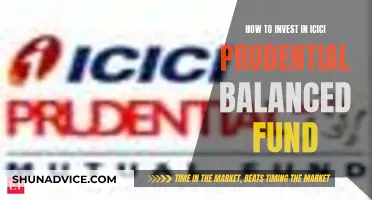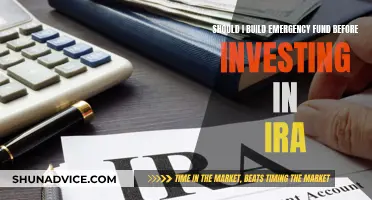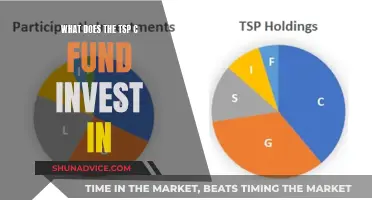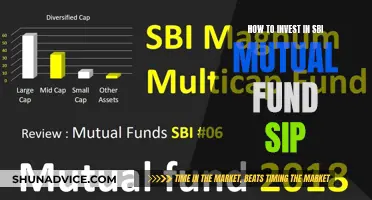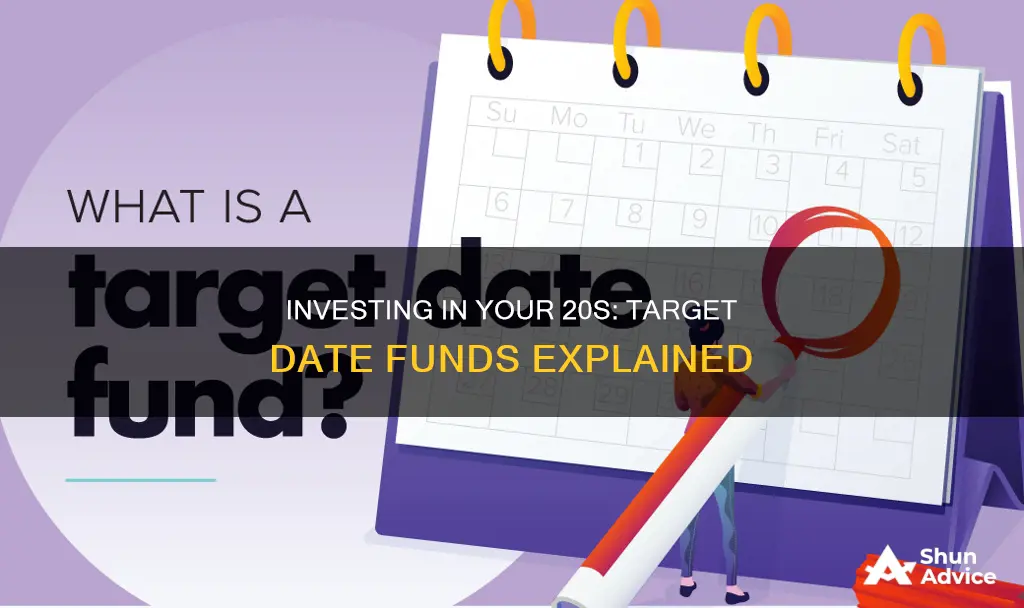
Investing in your 20s can have significant long-term benefits for building wealth. Setting clear financial goals is crucial for effective investment planning. Target-date funds are a set it and forget it retirement savings option that removes two headaches for investors: deciding on a mix of assets and rebalancing those investments over time. These funds are typically labelled by the intended year of retirement and use what is known as a glide path to shift exposure from higher-risk, potentially higher-reward assets to lower-risk ones over time.
| Characteristics | Values |
|---|---|
| Purpose | Retirement planning |
| Risk Management | Manage investment risk |
| Asset Allocation | Shift from higher-risk to lower-risk assets over time |
| Diversification | Instantly diversified portfolio |
| Investment Vehicles | Stocks, bonds, mutual funds, ETFs |
| Age | Designed for investors in their 20s |
| Time Horizon | Long time horizon |
| Fees | Expense ratios, fund performance |
| Glide Path | Reduce investment risk over time |
| Investment Mix | Stocks, fixed-income, cash, cash equivalents, bonds, treasury securities |
What You'll Learn

Understand risk and return
Risk and return are fundamental concepts in investing. Risk refers to the potential for loss, while return refers to the potential for profit. Understanding the relationship between risk and return is crucial for making informed investment decisions. Generally, the higher the risk, the greater the potential reward, and vice versa.
For example, consider the highly speculative nature of cryptocurrencies. Investing all your savings in Bitcoin when it first launched could have resulted in significant gains. However, this would have been an incredibly risky move, as there was no guarantee that Bitcoin would become popular or even continue to exist.
As a young investor in your 20s, it's important to assess your risk tolerance. Younger investors can typically afford to take on more risk than older investors, especially when it comes to retirement planning. This is because they have more time to recover from potential losses. On the other hand, older investors nearing retirement may prefer lower-risk, lower-reward investments like bonds or T-bills.
When evaluating investments, consider the risk levels associated with different asset classes, such as stocks, bonds, real estate, etc. Properly allocating your assets across these classes based on your risk tolerance and investment goals is essential for maintaining a diversified portfolio. Diversification helps protect your portfolio in case a particular asset class suddenly loses value, such as during a stock market crash.
Additionally, the level of risk and potential return can vary within each asset class. For example, within stocks, the risk and return potential can differ based on the sector, industry, and specific company you invest in. Therefore, it's crucial to conduct thorough research and due diligence before making any investment decisions.
ICICI Bank Debt Funds: A Comprehensive Investment Guide
You may want to see also

Choose the right investment vehicles
Some of the most common investment vehicles for young investors include stocks, bonds, mutual funds, and exchange-traded funds (ETFs). Each of these investment vehicles has its own pros and cons, which are important to understand before making any decisions.
Stocks
Stocks tend to be higher risk than bonds, although the level of risk depends on the sector, industry, and specific company. Over a long time horizon, a buy-and-hold strategy can yield tremendous returns, although this also depends on how you select stocks for investment. With thousands of stocks available, this can be a daunting area for young investors.
Bonds
Bonds provide a low-risk access point for investors. These investments often require less day-to-day management than stocks, although they are also limited in their potential for payout. A common approach is to allocate a percentage of your portfolio in bonds equal to your age, which means that many young investors may not focus heavily on this asset class.
Mutual Funds
Mutual funds are an excellent choice for many new investors. They provide broad diversification while minimising the amount of trading and oversight required. They are also good for a buy-and-hold strategy. However, mutual fund returns tend to be relatively modest.
ETFs
ETFs are a highly popular option among both new and seasoned investors. As baskets of other securities, ETFs provide a one-stop-shop approach for investors not eager to manage individual stocks or other assets. ETF risk and return profiles also vary considerably, allowing you to tailor your investment strategy to your risk tolerance.
Vanguard Mutual Funds: Are They Worth the Investment?
You may want to see also

Start investing early
Starting to invest early is one of the most important things you can do to ensure a stable financial future. The power of compounding growth means that money invested in your 20s can grow much more than money invested later in life.
For example, at just an annual 4% return, a dollar invested at age 20 would be worth nearly $6 by age 65. But if you'd invested that same dollar at age 30, it would only be worth about $4 at age 65.
To achieve this long-term growth, you'll need to gain access to the investing world as early as possible. A brokerage account is a good place to start. When you select a brokerage, look at fees, the types of assets offered, educational resources provided, customer support, and the user interface, as well as any other factors that may be important to you.
Some brokerages use robo-advisor tools to automate a large portion of the investment process, further reducing barriers to access for inexperienced investors.
Employer-Sponsored Retirement Plans
Employer-sponsored retirement plans such as 401(k) and 403(b) accounts are a must for any young investor. Many employers offer a contribution to those accounts without any input from an employee, meaning this is free money for you to set aside to compound over many years.
If a 401(k) isn't an option, or you're already earning a match, see if you meet the income requirements for a Roth IRA. Unlike a traditional IRA or a 401(k), it won't give you a tax break on contributions, but typically, you won't pay federal taxes when you pull money out in retirement. That's right: your contributions and investment earnings grow tax-free.
Manage Debt
For many young people, debt is a major hurdle to investing. Student loan debt, credit card debt, and other types of debt can present a financial burden.
To manage your debt, consider a debt-reduction system like the snowball method: list your debts in order of balance size, make all minimum payments, and then allocate any extra money to pay off the smallest debt first. This may achieve more immediate results in reducing the number of debts you have.
If you have student loans, be sure to pay close attention to federal programs that may help you reduce this burden. Staying on top of your payments will ensure you don't default on your loans, which can have a detrimental impact on your credit score.
Build an Emergency Fund
An emergency fund can protect your retirement savings. No matter how large your emergency fund is, you'll want to make sure it's in liquid assets that can be converted to cash quickly if needed.
Most professionals recommend having at least three to six months' worth of salary in an emergency fund to make sure you have a cushion in case the unexpected happens.
Offshore Hedge Fund Investment: Strategies and Secrets Revealed
You may want to see also

Manage debt and build an emergency fund
For many young people, debt is a major hurdle to investing. Student loan debt, credit card debt, and other types of debt can be a financial burden. To manage your debt, consider a debt-reduction system like the snowball method: list your debts in order of balance size, make all minimum payments, and then allocate any extra money to pay off the smallest debt first. This may achieve more immediate results in reducing the number of debts you have, and paying off high-interest debt will allow you to save more and boost your credit score.
If you have student loans, stay on top of your payments to ensure you don't default on your loans, which can negatively impact your credit score. Federal programs may be able to help you reduce this burden.
It's also important to build an emergency fund to protect your retirement savings. An emergency fund can be a cash reserve specifically set aside for unplanned expenses or financial emergencies, such as car repairs, home repairs, medical bills, or a loss of income. Without savings, even a minor financial shock could set you back, and if it turns into debt, it can have a lasting impact.
You can start building an emergency fund by setting a goal and creating a system for making consistent contributions, even if it's a small amount. You can also make your saving automatic by setting up recurring transfers from your checking account to your savings account.
- Snowball method: Focus on paying off the smallest debt first while making minimum payments on others.
- Stay on top of student loan payments and take advantage of federal programs to reduce the burden.
- Build an emergency fund: Set a goal and make consistent contributions, even if it's a small amount.
- Make saving automatic: Set up recurring transfers from your checking account to your savings account.
- Celebrate your successes: Recognize your accomplishments and treat yourself when you reach your goals.
Best Index Funds to Invest in India: A Guide
You may want to see also

Open retirement accounts
Opening a retirement account in your 20s is a great way to start investing for your future. Here are some detailed instructions on how to open a retirement account:
Step 1: Understand the different types of retirement accounts
Before opening a retirement account, it's important to understand the different types of accounts available. The most common types of retirement accounts are:
- 401(k) : This is an employer-sponsored retirement plan that allows you to contribute a portion of your paycheck pre-tax. Many employers will match a certain percentage of your contributions, which can boost your savings. The money in your 401(k) is invested in a diversified portfolio of stocks and bonds, and it grows tax-free until you withdraw it during retirement.
- Roth 401(k) : This is similar to a traditional 401(k), but you contribute after-tax dollars, and your investments grow tax-free. Withdrawals in retirement are typically tax-free as well.
- Individual Retirement Account (IRA) : You can open an IRA on your own, separate from an employer-sponsored plan. There are two main types of IRAs: traditional IRAs and Roth IRAs. With a traditional IRA, you contribute pre-tax dollars, and your contributions may be tax-deductible. With a Roth IRA, you contribute after-tax dollars, and your withdrawals in retirement are typically tax-free. IRAs also have annual contribution limits, which vary based on your age and income level.
- Health Savings Account (HSA) : An HSA is a tax-advantaged account that can be used for medical expenses. You can contribute pre-tax dollars, and the money grows tax-free. Starting at age 65, you can use the funds for any purpose without penalty, similar to a traditional IRA.
Step 2: Evaluate your options and choose a provider
Consider whether you have access to a 401(k) or similar employer-sponsored plan. If so, this may be the easiest option to start with, especially if your employer offers matching contributions. If you don't have access to an employer-sponsored plan, or if you've already contributed enough to get the full match, you may want to open an IRA. You can open an IRA with a brokerage firm, bank, or other financial institution. Compare fees, investment options, and features to find the best fit for your needs.
Step 3: Open and fund your account
Once you've chosen a provider, you can open your retirement account by filling out an application and providing any required documentation. You'll need to decide how much you want to contribute and set up a plan for funding your account. If you're using an employer-sponsored plan, you can usually set up automatic contributions from your paycheck. If you're opening an IRA, you may be able to set up automatic contributions from your bank account.
Step 4: Choose your investments
Once your account is open and funded, it's time to choose how to invest your money. If you're using a target date fund, this step may be taken care of for you, as these funds automatically adjust your asset allocation over time. If you're managing your investments yourself, consider your risk tolerance, time horizon, and financial goals when choosing investments. Diversification is important to balance risk and return.
Remember, investing for retirement is a long-term commitment, and it's never too early to start. By opening a retirement account and contributing regularly, you'll be taking a big step toward a more secure financial future.
Bond Mutual Funds: When to Invest for Maximum Returns
You may want to see also
Frequently asked questions
Investing in your 20s allows you to capitalize on compounding growth, meaning that your money invested now has the potential to increase more significantly over the course of your investment career than money invested later. This can help you tackle debt, establish savings, emergency and retirement accounts, and save for bigger financial goals.
The most important consideration is the target retirement date itself. Other considerations include the expense ratios of the fund and any constituent funds, overall fund performance, and which funds are available through your investment manager.
It's important to be aware that different funds may have fees that must be paid periodically. There is also a risk of target date funds oversimplifying the retirement planning process for some investors. It's crucial to compare the specifics of a fund against your own level of risk tolerance and financial goals.
There are three ways to invest in a target date fund. Firstly, target date funds are a common preset choice for a 401(k). Secondly, you can open a brokerage account with a fund manager or online broker to shop for target-date funds. Lastly, you can purchase one directly from a fund provider, although your choices may be more limited.


